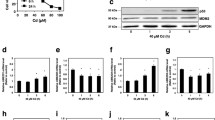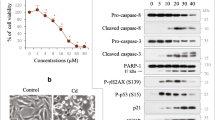Abstract
Cadmium exposure causes endoplasmic reticulum (ER) stress and accumulation of activating transcription factor 4 (ATF4), an ER stress marker. To elucidate the role of phosphatidylinositol-3-kinase (PI3K) signaling in this process, we examined the effects of PI3K signaling on cadmium chloride (CdCl2) exposure-induced ATF4 expression in HK-2 human renal proximal tubular cells. ATF4 knockdown by siRNA enhanced CdCl2-induced cellular damage, indicating a cytoprotective function of ATF4. Treatment with LY294002, a PI3K inhibitor, suppressed CdCl2-induced ATF4 expression and Akt phosphorylation at Thr308 with little effect on phosphorylation of eukaryotic translation initiation factor 2 subunit α at Ser51. Activation of PI3K signaling with epidermal growth factor treatment enhanced CdCl2-induced Akt phosphorylation and ATF4 expression. Suppression of CdCl2-induced ATF4 expression by LY294002 treatment was markedly blocked by cycloheximide, a translation inhibitor, but not by MG-132, a proteasome inhibitor, or actinomycin D, a transcription inhibitor. CdCl2 exposure also induced phosphorylation of mammalian target of rapamycin (mTOR) at Ser2448, glycogen synthase kinase-3α (GSK-3α) at Ser21, GSK-3β at Ser9, and 90 kDa ribosomal S6 kinase 2 (RSK2) at Ser227 in HK-2 cells. Treatment with rapamycin, an mTOR inhibitor, MK2206, an Akt inhibitor, and BI-D1870, a RSK inhibitor, partially suppressed CdCl2-induced ATF4 expression. Conversely, SB216763, a GSK-3 inhibitor, markedly inhibited the potency of LY294002 to suppress CdCl2-induced ATF4 expression. These results suggest that PI3K signaling diversely regulates the expression of ATF4 in a translation-dependent manner via downstream molecules, including mTOR, GSK-3α/β, and RSK2, and plays a role in protecting HK-2 cells from cadmium-induced damage.







Similar content being viewed by others
References
Alessi DR, James SR, Downes CP, Holmes AB, Gaffney PRJ, Reese CB, Cohen P (1997) Characterization of a 3-phosphoinositide-dependent protein kinase which phosphorylates and activates protein kinase Bα. Curr Biol 7:261–269
Anjum R, Blenis J (2008) The RSK family of kinases: emerging roles in cellular signalling. Nat Rev Mol Cell Biol 9:747–758
Barthel A, Ostrakhovitch EA, Walter PL, Kampkötter A, Klotz L-O (2007) Stimulation of phosphoinositide 3-kinase/Akt signaling by copper and zinc ions: mechanisms and consequences. Arch Biochem Biophys 463:175–182
Belham C, Wu S, Avruch J (1999) Intracellular signalling: PDK1—a kinase at the hub of things. Curr Biol 9:R93–R96
Cao H, Yu S, Yao Z, Galson DL, Jiang Y, Zhang X, Fan J, Lu B, Guan Y, Luo M, Lai Y, Zhu Y, Kurihara N, Patrene K, Roodman GD, Xiao G (2010) Activating transcription factor 4 regulates osteoclast differentiation in mice. J Clin Invest 120:2755–2766
Carpenter RL, Jiang B-H (2013) Roles of EGFR, PI3K, AKT, and mTOR in heavy metal-induced cancer. Curr Cancer Drug Targets 13:252–266
Chen L, Xu B, Liu L, Luo Y, Zhou H, Chen W, Shen T, Han X, Kontos CD, Huang S (2011) Cadmium induction of reactive oxygen species activates the mTOR pathway, leading to neuronal cell death. Free Radic Biol Med 50:624–632
Cross DAE, Alessi DR, Cohen P, Andjelkovich M, Hemmings BA (1995) Inhibition of glycogen synthase kinase-3 by insulin mediated by protein kinase B. Nature 378:785–789
Das F, Ghosh-Choudhury N, Kasinath BS, Choudhury GG (2010) TGFβ enforces activation of eukaryotic elongation factor-2 (eEF2) via inactivation of eEF2 kinase by p90 ribosomal S6 kinase (p90Rsk) to induce mesangial cell hypertrophy. FEBS Lett 584:4268–4272
Fang Y, Vilella-Bach M, Bachmann R, Flanigan A, Chen J (2001) Phosphatidic acid-mediated mitogenic activation of mTOR signaling. Science 294:1942–1945
Foster KG, Fingar DC (2010) Mammalian target of rapamycin (mTOR): conducting the cellular signaling symphony. J Biol Chem 285:14071–14077
Fujiki K, Inamura H, Matsuoka M (2013) Phosphorylation of FOXO3a by PI3K/Akt pathway in HK-2 renal proximal tubular epithelial cells exposed to cadmium. Arch Toxicol. doi:10.1007/s00204-013-1077-6
Hamada T, Tanimoto A, Sasaguri Y (1997) Apoptosis induced by cadmium. Apoptosis 2:359–367
Harding HP, Novoa I, Zhang Y, Zeng H, Wek R, Schapira M, Ron D (2000) Regulated translation initiation controls stress-induced gene expression in mammalian cells. Mol Cell 6:1099–1108
Harding HP, Zhang Y, Zeng H, Novoa I, Lu PD, Calfon M, Sadri N, Yun C, Popko B, Paules R, Stojdl DF, Bell JC, Hettmann T, Leiden JM, Ron D (2003) An integrated stress response regulates amino acid metabolism and resistance to oxidative stress. Mol Cell 11:619–633
Hers I, Vincent EE, Tavaré JM (2011) Akt signalling in health and disease. Cell Signal 23:1515–1527
Hotamisligil GS (2010) Endoplasmic reticulum stress and the inflammatory basis of metabolic disease. Cell 140:900–917
Inageda K (2010) Insulin modulates induction of glucose-regulated protein 78 during endoplasmic reticulum stress via augmentation of ATF4 expression in human neuroblastoma cells. FEBS Lett 584:3649–3654
Inagi R (2010) Endoplasmic reticulum stress as a progression factor for kidney injury. Curr Opin Pharmacol 10:156–165
Jefferson LS, Fabian JR, Kimball SR (1999) Glycogen synthase kinase-3 is the predominant insulin-regulated eukaryotic initiation factor 2B kinase in skeletal muscle. Int J Biochem Cell Biol 31:191–200
Jensen CJ, Buch M-B, Krag TO, Hemmings BA, Gammeltoft S, Frödin M (1999) 90-kDa ribosomal S6 kinase is phosphorylated and activated by 3-phosphoinositide-dependent protein kinase-1. J Biol Chem 274:27168–27176
Jing Y, Liu L-Z, Jiang Y, Zhu Y, Guo NL, Barnett J, Rojanasakul Y, Agani F, Jiang B-H (2012) Cadmium increases HIF-1 and VEGF expression through ROS, ERK, and AKT signaling pathways and induces malignant transformation of human bronchial epithelial cells. Toxicol Sci 125:10–19
Komoike Y, Inamura H, Matsuoka M (2012) Effects of salubrinal on cadmium-induced apoptosis in HK-2 human renal proximal tubular cells. Arch Toxicol 86:37–44
Lian N, Lin T, Liu W, Wang W, Li L, Sun S, Nyman JS, Yang X (2012) Transforming growth factor β suppresses osteoblast differentiation via the vimentin activating transcription factor 4 (ATF4) axis. J Biol Chem 287:35975–35984
Liu F, Inageda K, Nishitai G, Matsuoka M (2006) Cadmium induces the expression of Grp78, an endoplasmic reticulum molecular chaperone, in LLC-PK1 renal epithelial cells. Environ Health Perspect 114:859–864
Luo J-Q, Chen D-W, Yu B (2013) Upregulation of amino acid transporter expression induced by l-leucine availability in L6 myotubes is associated with ATF4 signaling through mTORC1-dependent mechanism. Nutrition 29:284–290
Matsuoka M, Call KM (1995) Cadmium-induced expression of immediate early genes in LLC-PK1 cells. Kidney Int 48:383–389
Mérienne K, Jacquot S, Zeniou M, Pannetier S, Sassone-Corsi P, Hanauer A (2000) Activation of RSK by UV-light: phosphorylation dynamics and involvement of the MAPK pathway. Oncogene 19:4221–4229
Misra UK, Gawdi G, Pizzo SV (2003) Induction of mitogenic signalling in the 1LN prostate cell line on exposure to submicromolar concentrations of cadmium. Cell Signal 15:1059–1070
Nordberg GF, Nogawa K, Nordberg M, Friberg LT (2007) Cadmium. In: Nordberg GF, Fowler BA, Nordberg M, Friberg LT (eds) Handbook on the toxicology of metals, 3rd edn. Academic Press, Burlington, pp 445–486
Pal S, Pal PB, Das J, Sil PC (2011) Involvement of both intrinsic and extrinsic pathways in hepatoprotection of arjunolic acid against cadmium induced acute damage in vitro. Toxicology 283:129–139
Peterson RT, Beal PA, Comb MJ, Schreiber SL (2000) FKBP12-rapamycin-associated protein (FRAP) autophosphorylates at serine 2481 under translationally repressive conditions. J Biol Chem 275:7416–7423
Romeo Y, Zhang X, Roux PP (2012) Regulation and function of the RSK family of protein kinases. Biochem J 441:553–569
Ron D, Walter P (2007) Signal integration in the endoplasmic reticulum unfolded protein response. Nat Rev Mol Cell Biol 8:519–529
Schröder M, Kaufman RJ (2005) ER stress and the unfolded protein response. Mutat Res 569:29–63
Son Y-O, Wang L, Poyil P, Budhraja A, Hitron JA, Zhang Z, Lee J-C, Shi X (2012) Cadmium induces carcinogenesis in BEAS-2B cells through ROS-dependent activation of PI3K/AKT/GSK-3β/β-catenin signaling. Toxicol Appl Pharmacol 264:153–160
Welsh GI, Miller CM, Loughlin AJ, Price NT, Proud CG (1998) Regulation of eukaryotic initiation factor eIF2B: glycogen synthase kinase-3 phosphorylates a conserved serine which undergoes dephosphorylation in response to insulin. FEBS Lett 421:125–130
Xiao W, Liu Y, Templeton DM (2009) Pleiotropic effects of cadmium in mesangial cells. Toxicol Appl Pharmacol 238:315–326
Acknowledgments
This study was supported by the Department Fund of the Tokyo Women’s Medical University School of Medicine.
Conflict of interest
The authors declare that they have no conflict of interest.
Author information
Authors and Affiliations
Corresponding author
Rights and permissions
About this article
Cite this article
Fujiki, K., Inamura, H. & Matsuoka, M. PI3K signaling mediates diverse regulation of ATF4 expression for the survival of HK-2 cells exposed to cadmium. Arch Toxicol 88, 403–414 (2014). https://doi.org/10.1007/s00204-013-1129-y
Received:
Accepted:
Published:
Issue Date:
DOI: https://doi.org/10.1007/s00204-013-1129-y




